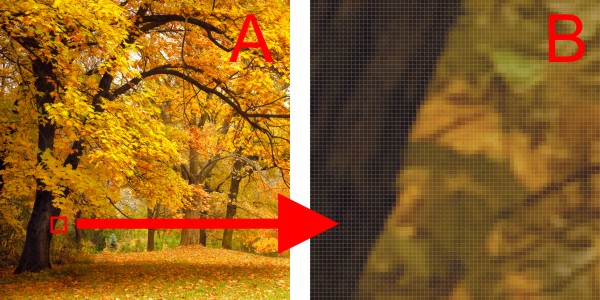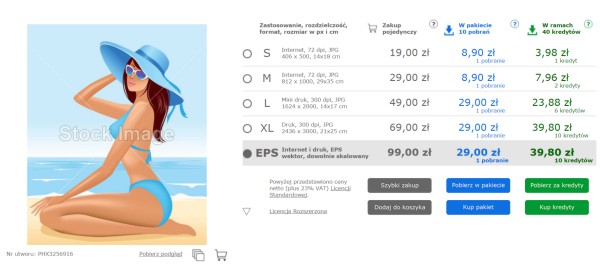Photogenica - CMS - Articels - 18.12.2015
Licensing at image banks: how big a file do I need?
Many image banks offer image pricing by the size and resolutions of files. You receive the size information in centimeters or pixels, sometimes also in kilobytes (kB) or megabytes (MB). Usually you need to pay more for bigger files. How to read the numbers and make sure that we do not overpay or buy a file that is too small?
Two basic graphics are used to store digital images: vector and raster (bitmap) graphics. The vector graphics are stored with the use of geometrical shapes (line segments, curves, polygons, circles, etc.) and coordinates. The raster images consist of small squares, so called pixels. If we place so many pixels on a surface that we stop perceiving their edges, we can see an image of photographic quality.
One of the advantages of vector graphics is that the images are scalable, so can be enlarged and reduced freely. It does not, however, give the photorealistic effect easily, and that is why it is used mainly to draw illustrations (such as comics), schemes, signs, maps, or drafts. Photography loves the raster graphics, because when we compress enough pixels, we can get wonderful, realistic images, whose quality increases with the number of pixels on a given surface.
|
 |
Examples of vector graphics in a form of a set of geometrical shapes. Such images can be enlarged to any size.
|
Digital photo cameras store images using raster graphics, so the images offered by image banks are mostly stored using this method, in most common formats such as JPG or TIF. In case an image is also offered in a vector format, the information is usually given that the image can be 'scaled to any size' or just as a 'vector'. The most common presently format of vector graphics is EPS, also the CDR format (Corel Draw software) is used. Vector images may be quite easily converted into raster images (the so called rasterization), whereas the raster-to-vector conversion (vectorization) is rather difficult and in some cases the results are not satisfactory, as the edges and shapes may not be recognized by computer software.
|
 |
|
An example of raster graphic used commonly by photo cameras. The obtained image is realistic if we compress enough pixels. The more pixels, the more details, and the gentler the tonal transitions we receive (example A). When we enlarge a raster image, the structure of the image becomes noticeable in the form of square pixels (example B).
|
As we know already, the vector graphics may be scaled to any size, so when we license such an image we have no problem with selecting the adequate file size. In case of raster graphic, it becomes more difficult, as we need to consider the intended usage of the image, particularly if the image is to be used in electronic devices or printed. The size description given for offered files helps in such cases. The easiest, and the most plausible parameter is the size given in pixels. It gives the information how many pixels the image consists of, in most cases both, the width and height of the image are given, e.g. 400 x 300 pixels (px).
When we license images to be used in electronic form (in Internet, etc.), it is enough when we remember that most people view Internet sites with ca. 1200 x 800 pixels screen settings. Files in this size will look perfect, even if viewed as a full screen. As such, they may make excellent screen savers or wallpapers. Practically, such images are viewed as a part of an Internet site, that is why files not bigger than 400 pixels are used, or even images with less than 100 pixels, especially when a given Internet site is intended for small mobile devices, such as tablets or smartphones.
In case we need the images to be printed, larger files must be selected. As in printing the term 'resolution' is often used, we might want to understand this notion. Resolution relates to the number of pixels compressed on a given surface; we say that an image is of 300 ppi (pixels per inch) if on each inch of the image there are 300 pixels. For example, an image of A4 size (ca. 11 x 8 inches) with the resolution of 300 ppi will have the file size of 3300 x 2400 pixels. To make sure we get a perfect print with an offset printing machine we may assume that the image should have 300 ppi resolution and the size of its intended print size. So if we need a print in A3 size, the image size should be ca. A3 with 300 ppi, that is ca. 5000 x 3500 pixels.
|
 |
|
|
Parameters of files offered by image bank Photogenica. The dimensions we give are in pixels, in centimeters with given resolution (72 or 300 ppi) as well as the file storing format. This image is available as a raster graphics (JPG files in various sizes), as well as vector graphics (EPS file, may be scaled to any size). |
For prints not bigger than A4 format, such as leaflets or folders, the 200 ppi resolution will also in most cases be sufficient. For prints bigger than A4, such as posters or calendars, 300 ppi resolution or bigger is recommended to ensure good quality. Large format prints (billboards, large decorations) are printed with ca. 100 ppi resolution. It is always a good idea to inquire at the printer's before licensing an image, bearing in mind that if you buy a slightly bigger file you may avoid problems with the print quality.
In case a bigger file is not available, interpolation, that is enlarging an image by adding new pixels may help. The colour of new pixels is calculated based on the existing adjacent pixels. We should remember that the interpolation process will not create additional details of the image, it creates only new, artificial pixels. Interpolation however, if moderately applied, may in some cases improve the visual quality of a print if a file of required size is not available. Most raster graphics editors have the built-in interpolation features. There is also professional interpolation software based on advanced mathematical algorithms that levels off the side effects of interpolation, such as loss of focus, adjusting the final image adequately.
Whereas enlarging by interpolation decreases the image quality along with the enlargement scale, the reverse process, that is reducing the image by eliminating some of the pixels is easier, and the visual quality of the image is not deteriorated. Image reducing may be useful when we license a file with print size, and then it turns out that it needs to be viewed in Internet additionally. Reducing the number of pixels in an image reduces the space it takes up on computer disc, and that in turn diminishes the site's weight, allowing it to load faster. It is always possible to license the same image again downloading a smaller file, which taking into account low prices of small files may turn out to be cheaper than conversion costs when we consider outsourcing this task from a graphic studio.
It is worth noting that the space taken up by an image on a computer disc, measured in kilobytes or megabytes, depends not only on the total number of pixels in an image, but also – to a great extent – on the compression method. The most common compression standard in the photo industry is JPEG, and files stored in this way have JPG extension. Image banks give also the file size in megabytes (MB) which refers to the size after decompression (that is when the JPG format is converted into a non compressed format, such as TIF). As a result, the size of a downloaded JPG file from a bank indicated by the computer is much smaller than the size according to the given description. To compare the file description data with the actual size of a downloaded file you need to decompress the file, that is to open it using a raster graphics editor, and then save it in a non-compressed format. The size of an A3 format file with 300 ppi (ca. 5000 x 3500 pixels) ranges usually between 30 – 60 MB (non compressed file), and 3 - 10 MB (compressed with a JPEG algorithm).
The biggest files offered by professional image banks are usually images stored in A3 format (42 x 29.7 cm) with 300 ppi resolution, that is ca. 5000 x 3500 pixels. Assuming that an image has been taken correctly, taking into consideration focus and exposure, the file of such dimensions ensures perfect quality for nearly all prints, even the large ones. If you are not sure about the future usage of the licensed image or graph, you might want to consider licensing the biggest file size available, which ensures flexibility of usage for various uses in the future.
|
Offer, pricing, information
About us
Subscribe our free newsletter
Please, wait...  | 

